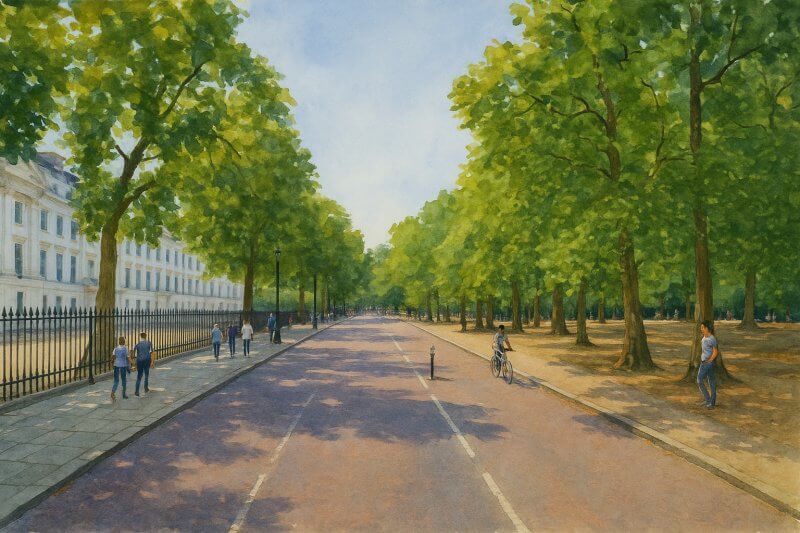
Birdcage Walk, London
Introduction
Birdcage Walk is a historic and scenic street located in the City of Westminster, running along the southern edge of St James’s Park. It offers visitors a picturesque walk steeped in royal history, connecting some of London’s most iconic sites.Location and Overview
Birdcage Walk runs in an east–west direction between Horse Guards Road on its eastern end and Buckingham Gate on its western side. The street is approximately 0.4 miles (0.6 kilometres) in length. On one side, it borders the beautiful greenery of St James’s Park, while on the other lies a row of elegant buildings and memorials.History of Birdcage Walk
The origins of Birdcage Walk date back to the early 17th century during the reign of King James I. It was initially part of the royal grounds of the Palace of Whitehall and used for leisurely pursuits by the monarch and court.In the early 1600s, King James I created an aviary within the park, filling it with exotic birds. The adjacent path, which provided access to the aviary and served as a royal promenade, became known as Birdcage Walk.
Over the centuries, Birdcage Walk evolved from a royal path into a public road, with its name enduring as a curious reminder of its unique beginnings.
Map of Birdcage Walk, London
How Birdcage Walk Got Its Name
The street was named after the royal aviaries that once lined this area, filled with exotic birds kept for the enjoyment of the monarch and court. The name "Birdcage Walk" was in common use by the mid-17th century, and it stuck even after the aviaries were long gone.Rather than being named after a person or another place, the street’s name is a direct reference to the literal birdcages that once lined the edge of St James’s Park.
Connecting Roads
Birdcage Walk is part of a network of historic streets in central London and connects to several important roads:- Horse Guards Road – at the eastern end, near Whitehall and Parliament Square.
- Storey’s Gate – runs north from Birdcage Walk toward Westminster Abbey.
- Spur Road – leading to the Victoria Memorial and Buckingham Palace.
- Buckingham Gate – at the western end, providing access to the surrounding area including Victoria.

Painting of Birdcage Walk (View full-size image here)
Buildings and Landmarks Along Birdcage Walk
Birdcage Walk is surrounded by important institutions and memorials that reflect both military and royal associations.On the north (park) side:
- St James’s Park – One of London’s oldest royal parks, providing a lush and peaceful environment for walkers.
- The Wellington Barracks – Home to the Foot Guards who perform the Changing of the Guard at Buckingham Palace.
- The Royal United Services Institute (RUSI) – A British defence and security think tank with a long history.
- The Guards Museum – Offers insights into the history of the five regiments of Foot Guards.
Nearest London Underground Stations
Birdcage Walk is well-served by several nearby London Underground stations, making it highly accessible:- St James’s Park Station – located to the northwest, served by the District and Circle lines.
- Westminster Station – to the southeast, served by the Jubilee, District, and Circle lines.
- Victoria Station – a short walk westward, served by the Victoria, District, and Circle lines, along with National Rail services.
Fun Fact
During the 19th century, Birdcage Walk had a rather exclusive status — it was originally closed to civilian traffic and used primarily by royalty and military personnel. In fact, the public wasn’t allowed to drive along it until after the 1820s.Another fun fact: Author Virginia Woolf described Birdcage Walk in her novel Mrs. Dalloway, emphasizing its romantic and historic atmosphere — a literary connection that continues to attract fans of her work to this very spot.
Why Visit Birdcage Walk?
Birdcage Walk is more than just a road — it is a tranquil and scenic passage steeped in royal heritage. Walking along its length offers a unique perspective of central London’s blend of natural beauty, military history, and royal tradition. It’s the perfect route for a leisurely stroll between two of London’s most famous landmarks: Buckingham Palace and Big Ben. Whether you're a local enjoying a peaceful walk or a tourist tracing the steps of kings and queens, Birdcage Walk is a delightful part of London’s urban fabric.Summary
To recap, Birdcage Walk is:- Located in the City of Westminster.
- Roughly 0.4 miles long, running east to west.
- Named after 17th-century royal birdcages once kept by King James I.
- Connected to several key roads including Horse Guards Road and Buckingham Gate.
- Flanked by St James’s Park to the north and military buildings like Wellington Barracks to the south.
- Accessible via nearby Underground stations: St James’s Park, Westminster, and Victoria.